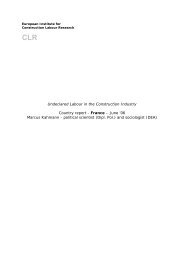In fact, trade unions have been more involved with volunteer activitiesthan ever. Many leaders engage in volunteer activities (<strong>Research</strong>Institute for Advancement of Living Standards, 1997a). A dedicated"Citizens and Volunteer Bureau" has also been established at RENGO(JTUC) which, in coordination with similar departments of industrialunions, shows the development in organisational approaches tovolunteer activities. Efforts to expand and deepen <strong>Japan</strong>ese industrialdemocracy to make it more open have been initiated.The contemporary period is called the age of individualisation,differentiation, and diversification. The more these trends advance,ho<strong>we</strong>ver, coordination of diversified stakes to achieve socialintegration becomes more critical. In this context, too, realisation of amore open industrial society is a strategic challenge of importance.The new trade union movement should open its role to a civil society,overcoming the closed nature of enterprise unions. It is very muchanticipated that the trade unions exert their organizational po<strong>we</strong>r toenvisage a new social movement, as they have the largest organisingability and social influence among "non-profit organizations".Many workers expect labour unions to play meaningful social roles,and a substantial portion is ready to respond to a call to join a union.According to the survey results on “What workers want for <strong>Labour</strong>Unions” by RENGO-RIALS in 2003, more than 20 percent (21.6%)responded that labour unions are absolutely necessary while 49.7percent said that unions are some<strong>what</strong> necessary, i.e. more than 70percent believe that unions are necessary.Moreover, many workers hope that the presence of labour unions willhelp improve rights, working conditions, and the <strong>we</strong>lfare of workers.In terms of the benefits to society as a whole, they cite protection ofworkers’ rights (73.8%), improvement in working conditions (50.1%),more gender equity over employment opportunities (24.4%), andclosing the gaps in working conditions among different industries andcompanies (20.4%). Improvement in employee benefits, the <strong>we</strong>lfaresystem and the work environment (53.6%), inclusion of employeeopinions in corporate management (48.8%), reduction of unfairpersonnel evaluations (24.3%), curbing personnel reductions (23.1%),more gender equity over employment opportunities (20.9%) andmaintenance of corporate ethics (15.2%) <strong>we</strong>re noted as benefits forunionised workers.Clearly, many workers see labour unions as a necessity. They believeCLR News No 2/200663
that unions <strong>can</strong> bring many positive benefits and expect unions toengage in many activities. Moreover, 13.2 percent of non-unionisedworkers are willing to join labour unions (would like to join at 3.2%and would consider joining at 10.2%). Examined by employment type,13.4 percent of regular employees and over 20 percent (22.4%) ofcontract and dispatched workers are willing to join. About 10 percent(9.7%) of part-time and casual workers are also willing to join.Signifi<strong>can</strong>tly, nearly one-third of those who believe labour unions areabsolutely necessary want to join a union.Perhaps, these three examples only amount to a very modest first stepand a potential that is only latent. Ho<strong>we</strong>ver, only by taking the firstsmall step forward and fulfilling such latent potential will unions beable to change the status quo. What is demanded from labour unionsnow is a leadership that seeks out an opportunity for futuredevelopment in the midst of a crisis. That opportunity is manifestingitself; it <strong>can</strong> be found in the desire for security and stability ofvocational life amidst the upheaval that exists in corporate society.The <strong>Japan</strong>ese trade unions need devote their entire energy to buildinga participatory industrial society, which must be the essentialrequirement to realise <strong>what</strong> workers want in their working lives.CLR News No 2/200664
- Page 1 and 2:
No 2/2006Japan - what can we learn?
- Page 3 and 4:
separate nation states, local build
- Page 6:
"shortening of exploitation's horiz
- Page 10 and 11:
The Japanese construction industry
- Page 12 and 13:
time could be up to 50 or more hour
- Page 14 and 15: The differences between sites in th
- Page 16 and 17: most of its importance since then.
- Page 18: But asked, who decides on the wages
- Page 21 and 22: policy were Toyota, Nissan, Canon,
- Page 23 and 24: Figure 2 C om position of Investm e
- Page 25 and 26: 3.2 Investment sheetSecondary, the
- Page 27 and 28: Maintenance and repairN ew construc
- Page 29 and 30: period of continuous cut back of or
- Page 31 and 32: enterprises, such as Nippon Steel C
- Page 33 and 34: of architectural design, engineerin
- Page 35 and 36: is constructed without blueprints.
- Page 37 and 38: task over again bearing the cost of
- Page 39 and 40: outsource every production function
- Page 41 and 42: so that any significant changeover
- Page 43 and 44: sixties or seventies who have retir
- Page 45 and 46: Immigration law allows residential
- Page 47 and 48: Today, domestic construction demand
- Page 49 and 50: 1993. Then there was a decrease to
- Page 51 and 52: Hundredmillion 億 円yen1400012000
- Page 53 and 54: workers belong to enterprise-based
- Page 55 and 56: trans-enterprise or industrial nego
- Page 57 and 58: Union (DENKI RENGO), Confederation
- Page 59 and 60: unions on their part have advocated
- Page 61 and 62: again. Industry specific federation
- Page 63: consult, while involved with variou
- Page 67 and 68: Figure 1. The Image of the J-CorpCo
- Page 69 and 70: References:OKAMOTO, Hideaki(1964) "
- Page 71 and 72: Nr. 3. Stress in the European const
- Page 73 and 74: We proudly present: a new publisher









